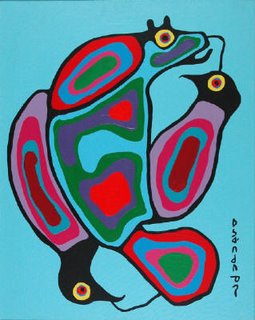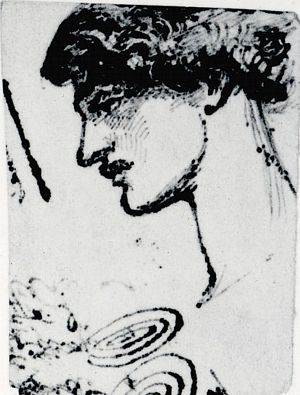Transaction and transformation.
 I'm not a particularly great tourist, as I started to explain the other night as I wrote about postcards. My curiosity tends to get focused swiftly and intensely and then to stay trained on whatever it is that has grabbed me. Case in point: today I wandered back to the excellent bookstore I'd discovered yesterday (Nicholas Hoare on Sussex) and browsed about there for a good long time (long enough to see the long-haired dark grey store cat again; we played peekaboo at one another for awhile before he was whisked off to have eye goop removed by one of the people running the store) and then picked my way through the street puddles to get back to the National Gallery. Today, I spent my time there prowling the museum store. Tomorrow, I'm going to stare at Norval Morrisseau's paintings, now up in a show called "Norval Morrisseau, Shaman Artist."
I'm not a particularly great tourist, as I started to explain the other night as I wrote about postcards. My curiosity tends to get focused swiftly and intensely and then to stay trained on whatever it is that has grabbed me. Case in point: today I wandered back to the excellent bookstore I'd discovered yesterday (Nicholas Hoare on Sussex) and browsed about there for a good long time (long enough to see the long-haired dark grey store cat again; we played peekaboo at one another for awhile before he was whisked off to have eye goop removed by one of the people running the store) and then picked my way through the street puddles to get back to the National Gallery. Today, I spent my time there prowling the museum store. Tomorrow, I'm going to stare at Norval Morrisseau's paintings, now up in a show called "Norval Morrisseau, Shaman Artist."My glimpses of Morrisseau's art over the past couple of days have been tantalizing, and the characterizations I'm reading of his work are no less so:
The show documents Morriseau’s progression as an artist, charting the creative and spiritual journey that would contribute to his unique style of painting known as “Woodland” or “Legend” painting, now called Anishnaabe, of which he is the originator. In works that evoke ancient symbolic etchings of sacred birchbark scrolls and pictographic renderings of spiritual creatures, Morrisseau “reveals” the souls of humans and animals through his unique “x-ray” style of imaging: Sinewy black “spirit” lines emanate, surround, and link the figures. Skeletal elements and internal organs are visible within the figures’ delineated segments. Saturated with startling, often contrasting colours, such paintings appear to vibrate under the viewer’s gaze.One of Morrisseau's goals has been to create art that can communicate the integrity of native culture to both native and non-native viewers. In other words, for the half-century he's been painting, Morrisseau has been attempting to make his artworks function as translators. This idea--I'd go so far as to call it an ethical project--coincides beautifully with a terrific and provocative talk I heard this morning, focused on the ethics of reading. I have long wanted to delineate for myself (and for my students) an idea of how reading can be a fundamental ethical act: how good reading might lead to good being, in other words, or at least to a striving and thirsting for goodness and justice. And so it was excellent to start my day by listening to a discussion of how reading creates the possibility of reflecting on ethics (I just typed "ethical reflection," but I have my fears that too much reflection might actually run counter to "the ethical," if we can even posit that abstraction). (I tend to get nervous when I start to use terms like "ethical"; I worry that a philosopher is going to come round the corner and tell me I'm misusing the term, that I don't know all of its ramifications, that I would need to read for years in order to speak the language correctly. It would be an ironic thing to get called out on, to my mind, since my motivation is entirely the opposite of self-aggrandizement or turf-stealing--is entirely an attempt to figure out the way to do something good.)
Our speaker encouraged us to consider the ethical possibilities of a process of reading considered as "transactional"--as fundamentally focused on a process of giving and receiving, a meeting of two minds, an "indeterminate sharing." In reading, she suggested (with reference to a range of current theorists), we can become vulnerable to beliefs that are not our own; we can move beyond our set, known personae by making ourselves open to others' ways of being (or even to the existence of otherness itself, or of alterity--simply a way to name all that is not our selves and world as we know them, all that is familiar). In fully present acts of reading, in other words, we test our boundaries. Sometimes, we test them only to find that (because the alterity we're encountering is simply unthinkable, for some reason) the test has strengthened our confidence and belief in what was already there. Sometimes, though, our tests reveal to us the fissures and faultlines in our habits and orientations (whether physical or intellectual or emotional). And what these possibilities mean is that reading should never simply be about escape or entertainment, though it certainly is those things as well (and either escape or entertainment could well have profound ethical ramifications).
I'm hoping for an experience of indeterminate sharing at the art museum tomorrow afternoon.

source for tonight's images: Both "Merging Elements" (1983) and "Traveling to Another Plane" (1994) come from the Kinsman Robinson Galleries, Morrisseau's principal dealer.


0 Comments:
Post a Comment
<< Home